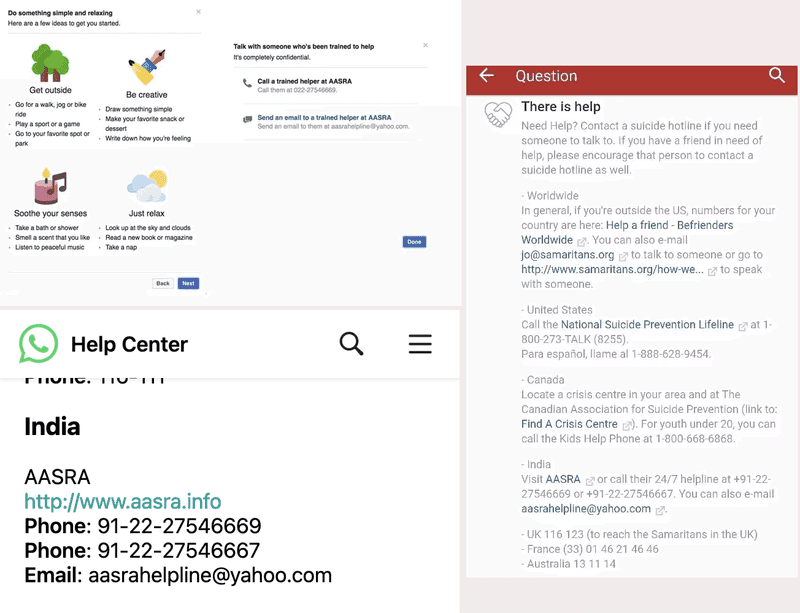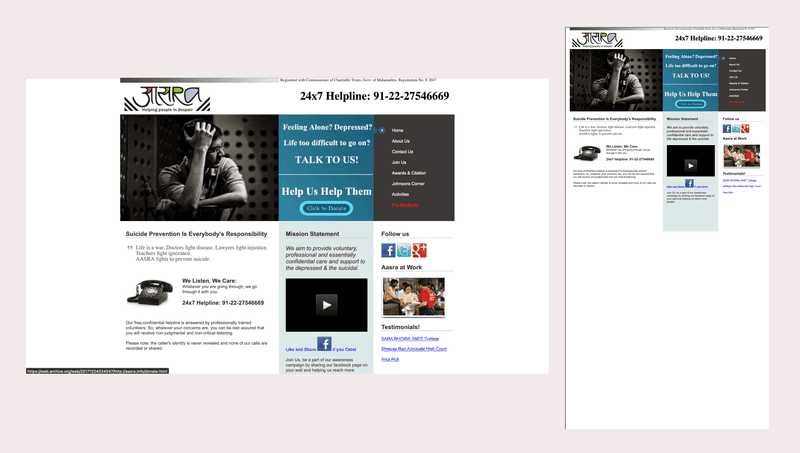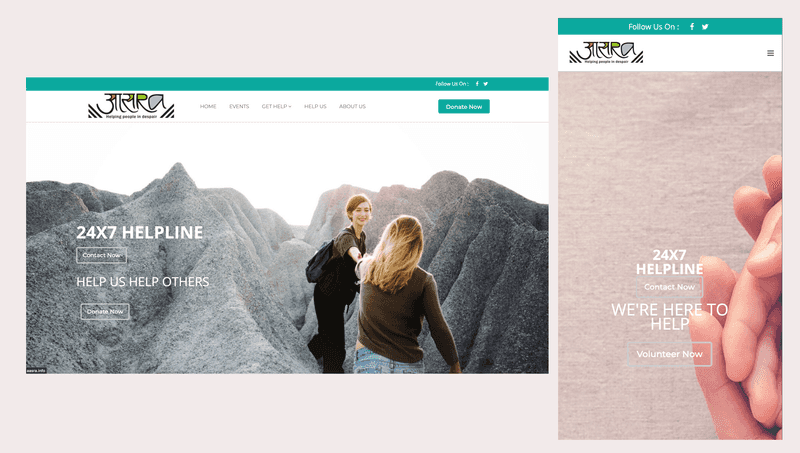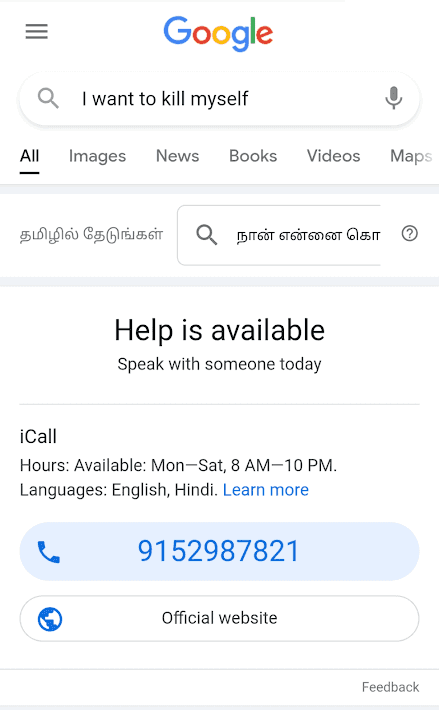Innovating for Impact - Improving India’s Critical Suicide Prevention Services
Initiating Change
Around 2018, I became involved with Enroot Innovation Foundation, an innovation-first organization dedicated to addressing social issues through the power of technology. Enroot leverages design thinking and engineering innovation to create sustainable solutions for social change.
A pivotal moment occurred around World Suicide Prevention Day on September 10th, 2018. A simple Google search for “suicide” brought up Aasra, a feature integrated by Google to display prompts for users in distress. Similarly, Aasra appeared on Facebook, Quora, and WhatsApp and other platforms.

This prompted me to investigate further. Aasra, part of Befrienders Worldwide/Samaritans, a UK-based charity, is linked to a global network including Volunteer Emotional Support Helplines (VESH), Lifeline International, and the International Federation of Telephone Emergency Services (IFOTES). Established in the 1990s, Aasra was among the first services in India dedicated to suicide prevention.
In January 2006, Aasra was honored with the Maharashtra Ratna Gaurav Puraskar after ten years of high-quality service and significant efforts in suicide prevention, highlighting its vital role and impact.
Challenges
On deeper dive into Aasra’s services revealed growing negative feedback. Users reported issues such as non-responsiveness, difficulty reaching the helpline, service denial, or inadequate support from counselors. This was quite shocking for an organization known to address such issues, especially for a service addressing people at the most vulnerable times of their lives and could, in fact, drive them to take drastic measures.
Platforms like Quora were filled with negative reviews and accounts of service denial, indicating this problem extended beyond Aasra to other helplines as well.


Understanding the Problem
To address the root causes effectively, it was essential to understand the problem from the organization’s perspective. Rishabh facilitated my contact with Johnson Thomas, the founder of Aasra. During our discussion, I presented our findings, including various reviews and feedback about the helpline’s performance. Johnson shared the historical context and the evolution of Aasra, highlighting the significant challenges they faced.
Johnson explained that Aasra started in the 1990s with a small group of 36 individuals dedicated to providing emotional support through a helpline. Initially, it was a local initiative focused on Mumbai. However, over time, Aasra gained recognition and numerous awards, which led to its inclusion in distress-related search results and social media prompts across India. This expansion drastically increased the demand for their services, which their infrastructure struggled to support.

He mentioned that according to government data, nearly 10 million-20 million Indians (1%-2% of the population) suffered from severe mental disorders such as schizophrenia and bipolar disorder, and nearly 50 million (5% of the population) suffered from common mental disorders such as depression and anxiety by the end of 2005. Even a small fraction of these individuals seeking help from Aasra resulted in an overwhelming burden on their helpline.
Despite their efforts, Aasra remained self-funded and reliant on donations, which limited their ability to scale operations to meet the growing demand. Additionally, many of the contact numbers listed on various platforms were outdated and non-functional, further compounding the issue. Despite repeated attempts to update these listings, Johnson’s efforts were unsuccessful, leading to significant frustration among users seeking immediate help.
- Outdated Numbers:
- Phone: 91-22-27546669
- Phone: 91-22-27546667
Rethinking, Engineering, Design, Execution
Phase 1: Website from a UI/UX Perspective
We started to rethink the problem. We did not have enough resources to either bring about changes in the law nor enough reach to raise huge amounts of funds. The only thing we knew was that thousands of people visited the Aasra website and called them daily.
So we started with just that. First, we did an analysis of the website. According to Google Analytics, 63% of the users that visited the website did so through mobile devices. However, the website was not device responsive, and the experience of navigating it through mobile was frustrating and not intuitive. This was another area of concern, especially for people at a vulnerable stage in their lives.

From the analysis of the website’s design, we identified several bad design components:
- Non-Responsive Design: The website did not adapt to different screen sizes, making it difficult to navigate on mobile devices.
- Cluttered Layout: The homepage was cluttered with too much text and information, overwhelming users.
- Outdated Contact Information: The helpline numbers displayed were outdated and no longer in service.
- Poor User Interface (UI): The design was not user-friendly, and important information was not highlighted effectively.
- Inconsistent Navigation: The navigation menu was not consistent, making it hard for users to find what they were looking for.
- Cold Imagery: The imagery used on the website was cold and unwelcoming, showing distress rather than providing a sense of warmth and openness that indicates support and help.
Archive link - Old Website before 2018
Engineering Improvements
To address these issues, we initiated the engineering improvements:
- Responsive Web Design: We rebuilt the website using responsive web design techniques to ensure it adapted to various screen sizes, improving accessibility and user experience on mobile devices.
- Backend Overhaul: We updated the backend infrastructure to ensure scalability and reliability, capable of handling increased traffic from across India. This included transitioning to a static website architecture and using content delivery networks (CDNs) to distribute content efficiently.
- Enhanced Load Times: We optimized the website’s performance to reduce load times, crucial for users in distress seeking immediate help. This was achieved through code minification, image optimization, and leveraging browser caching.
Design Enhancements

We also focused on design enhancements:
- Simplified Layout: We decluttered the homepage, prioritizing essential information and resources to make them easily accessible.
- User-Friendly Navigation: We designed a consistent and intuitive navigation menu, allowing users to find information quickly and effortlessly.
- Warm Imagery: We replaced cold, distressing images with warm, welcoming visuals that conveyed support and empathy.
- Clear Call-to-Actions: We added clear call-to-action buttons to guide users to immediate help or resources.
Through this, we were able to transform Aasra’s digital presence, making it more responsive, accessible, and user-friendly for those in need. This iterative approach allowed us to continually refine and improve the website, ensuring it met the needs of its users effectively.
Neha, Nemil, Avi, Aditya, Anirudh, and Harsh helped me in the redesign of the website based on the feedback we had received from various mental health specialists and psychologists working in this field.
Archive link - New Website post 2019
Phase 2: Addressing the Burden on the Helpline
In the second phase of rethinking, engineering, design, and execution, we focused on addressing the burden on the helpline and ensuring that people seeking help got access to the right resource at the most critical time.
For this, I and the team at Enroot Mumbai discussed various ways we could manage the traffic to the helpline and ensured people get access to the most critical resources at the essential time. This issue was bigger than the organization as denial of service to people in a vulnerable state could also mean potential loss of human life. The entire purpose here was to save human lives.
Hence, the team decided to create the most exhaustive list of suicide prevention helpline directory for India. Each team member researched the various organizations working in this sector and personally verified that all the helplines collected were functioning and providing the services as promised by them.
Navigating through this highly fragmented social sector was tough. There were private organizations, non-profits, hospitals, and even government organizations providing various offerings, and many outdated resources. Many of the numbers and helplines listed on websites and organizational pages were no longer functional, or the institutions had dissolved due to growing burden and lack of resources. After reviewing over 350 helplines and resources, the team was able to come up with 52 helplines that were functioning (last verified as of 2021).
The main ideas behind this were:
- If a helpline was busy or unavailable, users had the option to quickly go through the list and find another number.
- The numbers were sorted by states so that users could access the closest resources.
- Considering the numerous languages spoken in India, having helplines sorted by states made it possible for users to speak in their own mother tongue and convey their emotions easily.
From a design perspective, the numbers were also hyperlinked to a call-to-action, so users could simply click on the number, opening the dial pad on their mobile devices with the number already typed.
Another approach we implemented was to ensure that users landed on the Indian suicide helpline directory page to perform the call-to-action. This ensured that even if they wanted to call Aasra, the only place where the number was listed was on the helpline directory page. So, in case they were not able to reach the Aasra helpline, the same page provided them with ample alternative resources, thereby trying to minimize and manage distress in users.

You can check the Helpline directory - Archive link
Phase 3: Ensuring Better Alternatives on Social Media Platforms
Ensuring social media platforms like Facebook and Google listed better alternatives when users keyed in distressed-based words was another critical aspect.
For this, I worked alongside Prem at Enroot Innovation Foundation to advocate for listing the iCALL Psychosocial Helpline as the primary resource instead of Aasra. The reason was that out of all the helplines we had researched, iCALL had a better structure and support system.
iCALL, based at Tata Institute of Social Sciences, Mumbai, and sponsored by Mariwala Health Initiative (MHI), had numerous partnerships and collaborations, including:
- United Nations Population Fund
- Government of Madhya Pradesh
- Government of Gujarat
- Government of Maharashtra
- Larsen & Toubro Ltd.
- Tata Consultancy Services
- Dainik Bhaskar
- nULTA Healthcare Services Pvt. Ltd.
- Tata Starbucks
- TRAINN Circle
- Vishakha

I would like to thank Prem especially for this as he helped me coordinate with other Local Guides to ensure that Google delisted Aasra and instead listed iCALL, thereby helping achieve another important step towards ensuring people reach the right resource.
Outcome (as of 2021)
The helpline page (http://www.aasra.info/helpline.html) has 3,086 backlinks as of 2021, data sourced from Alexa Internet. This page has been referred to by many news outlets and newspapers as a source of helpline information. It has also been included in other distress helpline directories and websites, further enhancing its visibility and reliability as a critical resource for those in need.
Contribute to This Project
The complete code for this project is available on my GitHub repository. We welcome contributions from the community to help develop and enhance the technical infrastructure for suicide prevention. Your support and collaboration can make a significant impact.